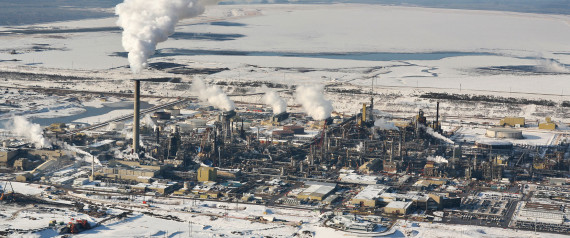CALGARY - Some types of crude oil have a drastically bigger carbon footprint than others, according to a report that ranks some oilsands varieties among the highest emitters.
In "Know Your Oil: Creating a Global Oil-Climate Index," researchers from the University of Calgary, Stanford University and the Carnegie Endowment for International Peace compared the greenhouse gas emissions of 30 varieties of crude from around the world.
Using publicly available information, they calculated emissions released at all stages of a barrel of crude's life — from the oilfield to the refinery to the tailpipe.
They found an 80 per cent difference between the highest and lowest carbon-emitting crudes.
Crudes derived from Suncor Energy Inc. and Syncrude Canada oilsands mines filled the highest and third-highest spots, respectively. Those are synthetic crudes, created by upgrading tarry oilsands bitumen into a light oil refineries can handle.
However, not all types of oilsands crude could be painted with the same brush. For instance, diluted bitumen from Cold Lake, where crude is pumped out using steam rather than mined, held the eleventh-highest spot.
Joule Bergerson, assistant professor at the Schulich School of Engineering at the University of Calgary, was responsible for crunching the numbers for the refining stage using a model that has been made publicly available.
Heavy oils, like those produced in the oilsands, do take more energy to extract, she said.
But to get a more accurate picture, she said it's important to look at other high-emitting culprits.
For instance, in some fields — like China's Bozhong field, the second-highest emitter on the list — producers burn off excess natural gas that's a byproduct of the extraction process. Fields in Venezuela and California round out the Top Five.
Oils from Norway and Kazakhstan were on the opposite tend of the spectrum.
"I would argue that yes, oilsands tend to be on the higher side of the emissions, but there are other crudes that are sort of comparable in terms of their emissions," said Bergerson.
"You can have a very light, easy to extract crude but if it comes with a lot of excess methane that is flared, your emissions can be quite high."
The work is far from over. Bergerson said the research team would like to expand the index to 50 crude varieties in the next six months.
One challenge has been getting access to the data from some regions. For instance, emissions from shale deposits in North Dakota and Texas — huge players in the global oil market — are conspicuously absent.
Bergerson hopes the Oil-Climate Index will help companies and policy-makers make wiser investment decisions by pinpointing where they can get the "biggest bang for your emission-reducing buck."
Original Article
Source: huffingtonpost.ca/
Author: Lauren Krugel
In "Know Your Oil: Creating a Global Oil-Climate Index," researchers from the University of Calgary, Stanford University and the Carnegie Endowment for International Peace compared the greenhouse gas emissions of 30 varieties of crude from around the world.
Using publicly available information, they calculated emissions released at all stages of a barrel of crude's life — from the oilfield to the refinery to the tailpipe.
They found an 80 per cent difference between the highest and lowest carbon-emitting crudes.
Crudes derived from Suncor Energy Inc. and Syncrude Canada oilsands mines filled the highest and third-highest spots, respectively. Those are synthetic crudes, created by upgrading tarry oilsands bitumen into a light oil refineries can handle.
However, not all types of oilsands crude could be painted with the same brush. For instance, diluted bitumen from Cold Lake, where crude is pumped out using steam rather than mined, held the eleventh-highest spot.
Joule Bergerson, assistant professor at the Schulich School of Engineering at the University of Calgary, was responsible for crunching the numbers for the refining stage using a model that has been made publicly available.
Heavy oils, like those produced in the oilsands, do take more energy to extract, she said.
But to get a more accurate picture, she said it's important to look at other high-emitting culprits.
For instance, in some fields — like China's Bozhong field, the second-highest emitter on the list — producers burn off excess natural gas that's a byproduct of the extraction process. Fields in Venezuela and California round out the Top Five.
Oils from Norway and Kazakhstan were on the opposite tend of the spectrum.
"I would argue that yes, oilsands tend to be on the higher side of the emissions, but there are other crudes that are sort of comparable in terms of their emissions," said Bergerson.
"You can have a very light, easy to extract crude but if it comes with a lot of excess methane that is flared, your emissions can be quite high."
The work is far from over. Bergerson said the research team would like to expand the index to 50 crude varieties in the next six months.
One challenge has been getting access to the data from some regions. For instance, emissions from shale deposits in North Dakota and Texas — huge players in the global oil market — are conspicuously absent.
Bergerson hopes the Oil-Climate Index will help companies and policy-makers make wiser investment decisions by pinpointing where they can get the "biggest bang for your emission-reducing buck."
Original Article
Source: huffingtonpost.ca/
Author: Lauren Krugel

No comments:
Post a Comment